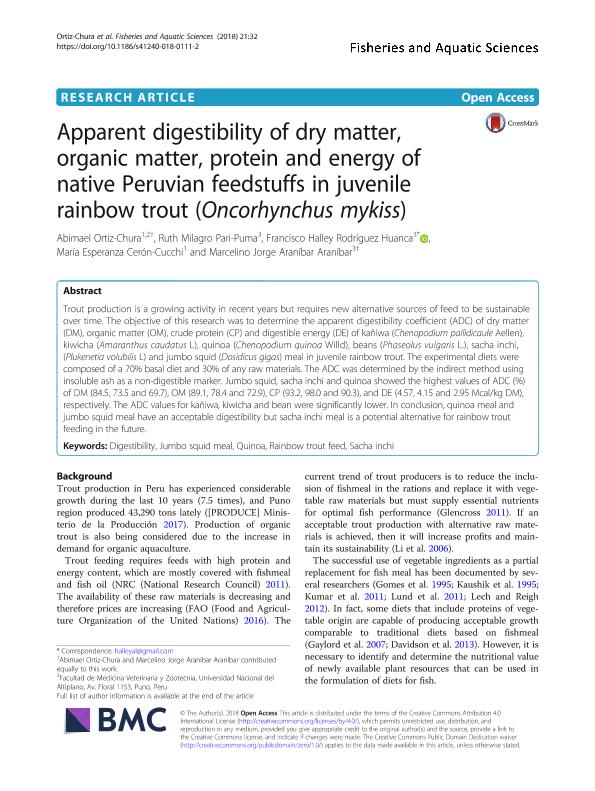Artículo
Apparent digestibility of dry matter, organic matter, protein and energy of native Peruvian feedstuffs in juvenile rainbow trout (Oncorhynchus mykiss)
Ortiz Chura, Abimael ; Pari Puma, Ruth Milagro; Rodríguez Huanca, Francisco Halley; Cerón Cucchi, María Esperanza
; Pari Puma, Ruth Milagro; Rodríguez Huanca, Francisco Halley; Cerón Cucchi, María Esperanza ; Araníbar Araníbar, Marcelino Jorge
; Araníbar Araníbar, Marcelino Jorge
 ; Pari Puma, Ruth Milagro; Rodríguez Huanca, Francisco Halley; Cerón Cucchi, María Esperanza
; Pari Puma, Ruth Milagro; Rodríguez Huanca, Francisco Halley; Cerón Cucchi, María Esperanza ; Araníbar Araníbar, Marcelino Jorge
; Araníbar Araníbar, Marcelino Jorge
Fecha de publicación:
11/2018
Editorial:
BioMed Central
Revista:
Fisheries and Aquatic Sciences
ISSN:
2234-1749
e-ISSN:
2234-1757
Idioma:
Inglés
Tipo de recurso:
Artículo publicado
Clasificación temática:
Resumen
Trout production is a growing activity in recent years but requires new alternative sources of feed to be sustainable over time. The objective of this research was to determine the apparent digestibility coefficient (ADC) of dry matter (DM), organic matter (OM), crude protein (CP) and digestible energy (DE) of kañiwa (Chenopodium pallidicaule Aellen), kiwicha (Amaranthus caudatus L), quinoa (Chenopodium quinoa Willd), beans (Phaseolus vulgaris L.), sacha inchi, (Plukenetia volubilis L) and jumbo squid (Dosidicus gigas) meal in juvenile rainbow trout. The experimental diets were composed of a 70% basal diet and 30% of any raw materials. The ADC was determined by the indirect method using insoluble ash as a non-digestible marker. Jumbo squid, sacha inchi and quinoa showed the highest values of ADC (%) of DM (84.5, 73.5 and 69.7), OM (89.1, 78.4 and 72.9), CP (93.2, 98.0 and 90.3), and DE (4.57, 4.15 and 2.95Mcal/kg DM), respectively. The ADC values for kañiwa, kiwicha and bean were significantly lower. In conclusion, quinoa meal and jumbo squid meal have an acceptable digestibility but sacha inchi meal is a potential alternative for rainbow trout feeding in the future.
Palabras clave:
DIGESTIBILITY
,
JUMBO SQUID MEAL
,
QUINOA
,
RAINBOW TROUT FEED
,
SACHA INCHI
Archivos asociados
Licencia
Identificadores
Colecciones
Articulos (IPVET)
Articulos de INSTITUTO DE PATOBIOLOGIA VETERINARIA
Articulos de INSTITUTO DE PATOBIOLOGIA VETERINARIA
Citación
Ortiz Chura, Abimael; Pari Puma, Ruth Milagro; Rodríguez Huanca, Francisco Halley; Cerón Cucchi, María Esperanza; Araníbar Araníbar, Marcelino Jorge; Apparent digestibility of dry matter, organic matter, protein and energy of native Peruvian feedstuffs in juvenile rainbow trout (Oncorhynchus mykiss); BioMed Central; Fisheries and Aquatic Sciences; 21; 1; 11-2018; 1-7
Compartir
Altmétricas



